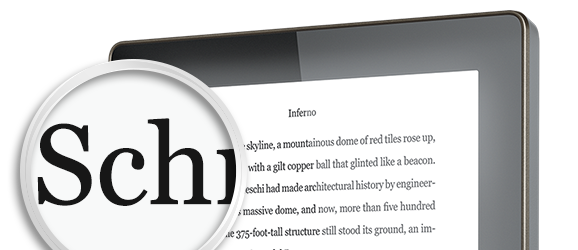
E-reader company Kobo has revealed its new e-reader lineup, including its first e-ink device to have a "totally flat" front.
The new Aura’s edge-to-edge display is designed to help it stand out from rival e-readers which normally feature a receded screen within a frame.
The device is being priced at a premium to Amazon’s competing Kindle Paperwhite and Barnes & Noble’s Nook Simple Touch.
Analysts have said the dedicated e-reader market is shrinking faster than predicted due to falling tablet prices.
Kobo does have a range of Android-powered multimedia tablets, which have also been revamped to take advantage of faster processors.
The global market in dedicated e-readers peaked in 2011 with 23 million devices sold, according to the research consultancy Gartner.
The firm said sales have since declined to the point that only 16 million such machines are forecast to be bought this year, with the number expected to fall to 10 million in 2017.
E-ink screens are easier to read in sunlight and are less likely to cause eyestrain than the LCD displays commonly used in tablets, but Gartner said that many consumers are unwilling to buy both devices.
"It is not that consumers have lost interest in e-books – rather, consumers have chosen instead to read e-books on other devices," Gartner analyst Hugues De La Vergne wrote in a report on the sector.
Kobo also has a new 10in (25.4cm) Android tablet which can be used to read magazines.
"Tablets can perform many functions, including supporting e-reader applications. Although many avid readers will still prefer a standalone reading device, most people will see no justification for the additional expense of buying a dedicated e-reader, unless it’s significantly less costly than a tablet."
Kobo has made the latest Aura cheaper than its previous version, which was £140. It is now the same price as Sony’s PRS-T2 Reader, but £11 more than Amazon’s bestselling Kindle Paperwhite and £51 more than the equivalent Nook.
For the price, Kobo is promising "the most even front-light" of any such device, addressing criticism that other machines make parts of their screen brighter than other areas when viewed in a dark room.
It has also teamed up with the service Pocket to make it easy to save articles from the web so that they can be synched and read on the Aura later.
In addition the firm has switched to using a capacitive touchscreen. This takes advantage of the way a user’s fingers disrupt an electrical field to provide more accurate feedback than the infrared tech used in Kobo’s Glow e-readers.
"It gives the ability to pinch-and-zoom when you want to zoom in on a particular piece of text or image," the firm’s general manager of devices Wayne White told the BBC.


